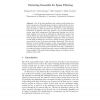Free Online Productivity Tools
i2Speak
i2Symbol
i2OCR
iTex2Img
iWeb2Print
iWeb2Shot
i2Type
iPdf2Split
iPdf2Merge
i2Bopomofo
i2Arabic
i2Style
i2Image
i2PDF
iLatex2Rtf
Sci2ools
HAIS
2011
Springer
2011
Springer
Clustering Ensemble for Spam Filtering
One of the main problems that modern e-mail systems face is the management of the high degree of spam or junk mail they recieve. Those systems are expected to be able to distinguish between legitimate mail and spam; in order to present the
nal user as much interesting information as possible. This study presents a novel hybrid intelligent system using both unsupervised and supervised learning that can be easily adapted to be used in an individual or collaborative system. The system divides the spam
ltering problem into two stages:
rstly it divides the input data space into dierent similar parts. Then it generates several simple classi
ers that are used to classify correctly messages that are contained in one of the parts previously determined. That way the e
ciency of each classi
er increases, as they can specialize in separate the spam from certain types of related messages. The hybrid system presented has been tested with a real e-mail data base and a comparison of its results wi...
| Added | 28 Aug 2011 |
| Updated | 28 Aug 2011 |
| Type | Journal |
| Year | 2011 |
| Where | HAIS |
| Authors | Santiago Porras, Bruno Baruque, Belén Vaquerizo, Emilio Corchado |
Comments (0)

